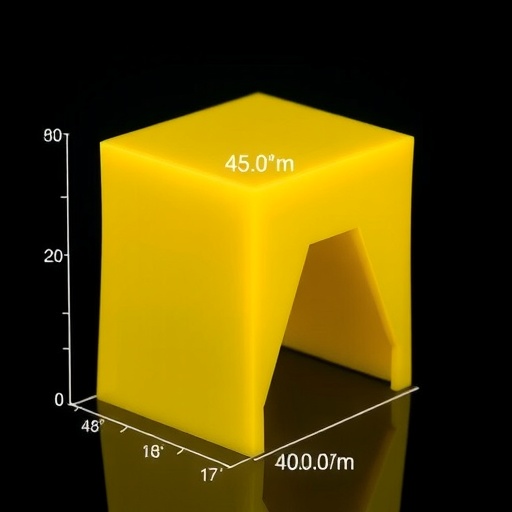In the rapidly evolving landscape of additive manufacturing, understanding the intricate relationship between printing parameters and the resulting mechanical properties of materials has become a pivotal research frontier. A recent study led by Hernandez, K.M., O’Brien, S., and Bischoff, A., among others, offers groundbreaking insights into how varying 3D printing settings influence the characteristics of ULTEM 9085, a high-performance thermoplastic widely utilized in aerospace and automotive industries. By merging rigorous experimentation with the predictive capabilities of machine learning, this research pioneers a more precise and efficient pathway to optimize 3D printed components for critical applications.
ULTEM 9085, known for its exceptional strength-to-weight ratio, thermal stability, and flame-retardant properties, has increasingly gained prominence as the material of choice for structurally demanding additive manufacturing tasks. However, the inherent complexity of 3D printing processes means that tweaking parameters such as layer thickness, print speed, and raster angle can lead to significant variations in mechanical performance. Therefore, this study’s comprehensive approach of coupling experimental data with sophisticated algorithms stands out as a transformative methodology in the quest for tailored material properties through additive manufacturing.
Central to the study is the recognition that traditional trial-and-error methods for parameter optimization are both time-consuming and resource-intensive. By integrating machine learning models trained on extensive experimental datasets, the researchers demonstrate an ability to predict mechanical outcomes such as tensile strength, flexural modulus, and impact resistance with remarkable accuracy. This fusion of empirical and computational techniques not only accelerates the optimization process but also unlocks deeper understanding into how specific parameter interactions govern material behavior at micro and macro scales.
One of the notable elements of this research is the careful selection of 3D printing parameters subjected to analysis. The team systematically varied layer height, infill density, raster angle, print temperature, and print speed, thereby capturing a broad spectrum of conditions typical in industrial 3D printing environments. Each configuration underwent rigorous mechanical testing—ranging from tensile to flexural and impact assessments—to map out the performance landscape of ULTEM 9085. This exhaustive characterization serves as the foundation upon which machine learning models could reliably infer novel parameter-property relationships.
The experimental framework employed meticulous specimen preparation protocols to ensure consistency and reproducibility. Samples were printed using industry-standard fused filament fabrication equipment, with stringent control over environmental factors such as ambient temperature and humidity. This approach mitigated external variables that could skew mechanical testing results, thus preserving the integrity of the dataset for subsequent algorithmic training. The commitment to stringent experimental rigor bolsters confidence in the nuanced trends revealed by the study.
In parallel, the data-intensive nature of the investigation necessitated the application of advanced machine learning techniques. The team evaluated multiple algorithmic frameworks, including random forests, support vector machines, and neural networks, to uncover the most effective for modeling complex, nonlinear relationships inherent in additive manufacturing processes. Through systematic hyperparameter tuning and cross-validation, the study identified optimal models capable of generalizing beyond training data, enabling robust performance predictions across unseen parameter combinations.
The integration of machine learning extends beyond mere prediction, illustrating a novel paradigm where algorithms actively guide experimental design. By analyzing feature importance and sensitivity metrics, the researchers elucidated the dominant printing parameters influencing each mechanical property. For example, print temperature emerged as a critical factor in achieving superior tensile strength, while raster angle significantly impacted flexural behavior. Such insights pave the way for data-informed decision-making in 3D printing, where operators can prioritize adjustments based on their material performance goals.
Another fascinating revelation from the study concerns the interplay between printing parameters and anisotropy in mechanical properties. Due to the layered nature of additive manufacturing, materials frequently exhibit directional dependencies that can undermine structural integrity under real-world loading conditions. The researchers’ analyses revealed how specific combinations of raster angle and layer height either exacerbate or mitigate these anisotropic effects in ULTEM 9085. Consequently, the findings serve as a blueprint for engineering more isotropic parts without compromising print efficiency.
The relevance of this work stretches beyond the laboratory and into industry, where the demand for lightweight, durable components is continually escalating. Aerospace manufacturers, for instance, increasingly rely on ULTEM 9085 for its compliance with stringent regulatory standards and mechanical robustness. By enabling precise tuning of printing conditions based on predictive models, the study empowers these sectors to cut development cycles and reduce material wastage while upholding critical safety margins.
Furthermore, the methodology advanced in this research reflects a broader trend towards digital manufacturing ecosystems powered by artificial intelligence. The coupling of experimental data with machine learning not only optimizes material performance but also facilitates real-time adaptive control during printing. Imagine a future where printers ingest continuous sensor feedback, adjust process parameters instantaneously, and autonomously ensure that each part meets exacting specifications—this study lays foundational groundwork towards such intelligent manufacturing systems.
Notably, the study also underscores the importance of multi-objective optimization in additive manufacturing. Mechanical property enhancement frequently requires balancing competing factors—for instance, maximizing tensile strength while minimizing print time or cost. The researchers’ framework accommodates these trade-offs by enabling tailored predictions across diverse parameter spaces, thus offering manufacturers customizable pathways aligned with specific production priorities.
In addition to improving functional properties, controlling 3D printing parameters also affects surface quality and dimensional accuracy—attributes that are crucial for customer satisfaction and component interoperability. Although not the primary focus of this work, the comprehensive dataset and machine learning models established herein provide a platform for future investigations into how mechanical and aesthetic characteristics co-evolve based on printing strategies.
This study’s implications resonate strongly with sustainability ambitions in manufacturing. By refining parameter selection through predictive analytics, the approach reduces trial runs and waste material, thus curtailing resource consumption and environmental impact. As industries move towards greener production paradigms, insights drawn from such data-driven research will be instrumental in designing leaner, more efficient additive processes.
The convergence of materials science, mechanical engineering, and machine learning epitomized by this research heralds a new era for 3D printing. By uniting human expertise with computational intelligence, it transcends the traditional boundaries between physical experimentation and digital modeling. Such synergy unlocks unprecedented opportunities to customize materials and structures with granular control, fundamentally reshaping how engineers conceive, fabricate, and deploy advanced components.
As additive manufacturing continues its ascent across industrial sectors, the knowledge generated through this study marks a critical leap forward. Not only does it demystify the complex influence of printing parameters on ULTEM 9085’s mechanical properties, but it also showcases the power of interdisciplinary approaches to tackle multifaceted problems. Looking ahead, the integration of real-time data acquisition, cloud computing, and machine learning promises to accelerate innovation cycles, leading to smarter, stronger, and more sustainable 3D printed materials.
Ultimately, the work by Hernandez and colleagues represents a compelling case study in the possibilities unlocked when experimentation meets machine learning in additive manufacturing. Their findings transcend the specifics of ULTEM 9085 to offer a blueprint for the broader materials community eager to harness AI-driven insights. In an era where customization, agility, and precision are paramount, such research charts a visionary course towards the next generation of manufacturing excellence.
Subject of Research: Influence of 3D printing parameters on the mechanical properties of ULTEM 9085 thermoplastic using a combination of experimental testing and machine learning techniques.
Article Title: Influence of 3D printing parameters on ULTEM 9085 mechanical properties using experimentation and machine learning.
Article References:
Hernandez, K.M., O’Brien, S., Bischoff, A. et al. Influence of 3D printing parameters on ULTEM 9085 mechanical properties using experimentation and machine learning. npj Adv. Manuf. 2, 41 (2025). https://doi.org/10.1038/s44334-025-00049-6
Image Credits: AI Generated
Tags: 3D printing parametersadditive manufacturing researchaerospace 3D printing applicationsefficient 3D printing methodsexperimental data and algorithmsflame-retardant thermoplasticsmachine learning in 3D printingmechanical properties of thermoplasticsoptimization of printing settingsstrength-to-weight ratio of ULTEMthermal stability in additive manufacturingULTEM 9085 material properties






